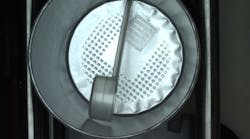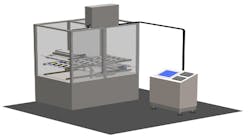MAY 10--US Library of Congress-sponsored research will help Berkeley Lab (Lawrence Berkeley National Laboratory, California; www.lbl.gov) physicists digitize audio data encoded in the hill-and-valley surface of Edison wax cylinders. This three-dimensional scan of a portion of a cylinder was acquired with a noncontact confocal optical probe and provided by STIL SA of Aix-en-Provence, France. "We developed a way to image the grooves in a recording that is similar to measuring tracks in a particle detector," says Carl Haber, a senior scientist in Berkeley Lab's Physics Division who developed the technology along with fellow Physics Division scientist Vitaliy Fadeyev.
The work could ultimately enable the Library of Congress to digitize the thousands of blues, classical, Dixie, jazz, and spoken-word recordings in its archives. The mass digitization of these aging disks and cylinders will both preserve the nation's musical history and make it accessible to a wide audience.
The collaboration, which is rooted in a Feb. 23 agreement between the Library of Congress and Berkeley Lab to conduct media-preservation research, takes advantage of Berkeley Lab's decades of experience developing ways to analyze the flood of data generated by high-energy physics experiments. This work, conducted at accelerators located at Fermilab and the European Center for Particle Physics in Geneva, requires the ability to image the tracks made by elementary particles as they hit detectors, and find these tracks amid a jumble of meaningless noise."We thought these methods, which demand pattern recognition and noise suppression, could also analyze the grooved shapes in mechanical recordings," says Haber.
To test their hunch, Fadeyev and Haber turned to a precision optical metrology system used by Berkeley Lab physicists to inspect silicon detectors destined for the upcoming ATLAS experiment, which will search for a theorized but never observed particle called the Higgs Boson. Instead of measuring silicon detectors, however, they programmed the system to map the undulating grooves etched in shellac phonograph discs. The images were then processed to remove scratches and blemishes, and modeled to determine how a stylus courses through the undulations. Lastly, the stylus motion was converted to a digital sound format.
The result is a digital reproduction of a mechanical recording, with each wiggle, bump and ridge in the recording's grooves faithfully captured, and each scratch ironed out. In this way, The Weavers' 1950 rendition of the classic Huddie Ledbetter (aka Leadbelly) song, Goodnight Irene, is closely mirrored--minus the hisses, pops, and scratches. The same goes for Nobody Knows the Trouble I've Seen. The nearly 60-year-old mechanical recording sounds worn and scratchy, but the digital rendition rings clear, just as Anderson sang it in 1947.
"We had to use the metrology system in a new way and measure a groove before we even knew its shape," says Fadeyev. "This enabled us to develop a noncontact way to measure delicate samples without the need for much operator intervention. It also has the potential to digitally reassemble broken discs."
Next, Fadeyev and Haber will advance the study of ways to recover damaged and worn cylinders, as well as study the entire three-dimensional profile of a disk's grooves. Although still under development, the technology could eventually give the Library's staff a better method to restore some of the 500,000 items it provides preservation treatments to each year, from a collection of nearly 128 million items in all formats.
"The groundbreaking research that our colleagues at Berkeley Lab are undertaking signals an important new direction for preservation of collections of this type, which we hope will be of benefit to libraries and archives everywhere," says Mark Roosa, the Library's director for preservation.
In addition to preserving the past, mass digitization gives the public greater access to thousands of old recordings, some so fragile that even the touch of a stylus could damage them. Of course, mass digitization hinges on shepherding the technology far beyond its current research-and-development stage, which is familiar work to Berkeley Lab physicists who have designed and built detectors that have gone on to observe elementary particles like the top quark.
"In the same way, we want to take what we know about audio preservation and help the Library of Congress preserve their collection and make it accessible to the public," says Haber. "It's also a good example of how basic research in the physical sciences can benefit other fields of science and culture."




